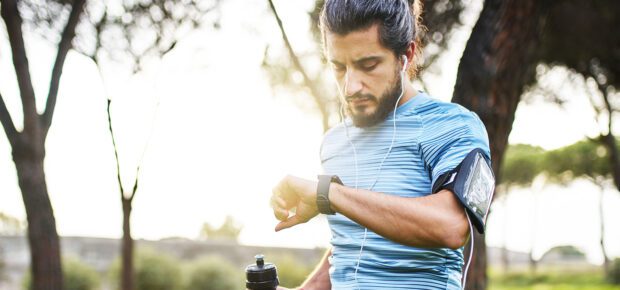March 7, 2023
From smartphones and televisions to exercise equipment and smart watches, the number of connected devices is growing rapidly. Consumers are using them: the average number of connected devices in homes grew by 10% globally in 2022 to 17, according to a recent report.
And if you stop to look around, there’s no shortage of seemingly mundane products that are suddenly gaining unexpected functionalities. Smart toilets can monitor for disease. Light bulbs change color via an app on our phones. Iconic clothing items, like the denim jacket, are also gaining digitally-enhanced superpowers to let users access notifications on their cuffs.
Carmen Fontana, an IEEE member and expert in wearable health devices, recently discussed these and other trends at a panel held in Barcelona as part of Mobile World Congress (MWC), the world’s largest gathering of the mobile technology industry. She took a moment to talk about the promises and limitations of a world in which connectivity is baked into everything.
The panel you participated in was called “Is There Anything That Can’t Be Connected?” So let’s start with that as our obvious first question. Is there anything that can’t be connected? We’ve read articles about connected bathing suits and connected socks recently.
I think the better question is ‘is it practical for this thing to be connected?’ A connected bathing suit that analyzes UV rays and reminds you to wear sunscreen may be a fun pool side party trick, but does the extra cost justify the gains? It’s a lot simpler and cheaper to just reapply sunscreen regularly. That said, there was a time when we thought no one would need to converse with their phone, and here we are with Siri and Alexa commanding our lives.
Never underestimate the limits of human ingenuity!
Is there anything that isn’t currently connected that you wish was?
Before we connect any more devices, I just wish my existing devices were better connected. In my dream world, my smartwatch would wake me up at the optimal point in my sleep cycle. That would automatically start my electric kettle and speaker system. Both devices would interpret the metrics from my smartwatch and adjust their settings accordingly. If my health metrics show I may be coming down with a cold, my kettle would blend a tea with a little extra Vitamin C to fend off illness. And if my smartwatch said I slept poorly, my speaker system would choose soft, but uplifting music, to help me ease into the day.
The makers of connected home appliances have found that only a very small percentage of consumers connect them to the internet. In your own area of expertise, health care, are you seeing the same thing? What can businesses do to help consumers see value in connectivity?
One of the biggest challenges with connected devices is usability. I have a number of smart appliances in my home, and every single one of them works completely differently. Not to mention they all have their own app that I need to learn to navigate. It can be confusing.
I also notice that a lot of smart devices just tell you data versus interpreting or acting on the data. Yes, you can see your heart rate trends from your wearable. But what does it mean? Should you be concerned? When should you contact a doctor?
A truly smart device needs to analyze and recommend actions. That is valuable to the consumer, and that will drive adoption.
How are wearables changing the way people engage with their own health care? Are wearables increasing patient compliance with treatment plans or making people stick to their New Year’s resolutions?
Wearables allow people to feel empowered about their health.
There is a famous study comparing different diet plans. In the end, the diet that was most effective was the one that simply had people logging the foods they ate. In their most basic form, wearables work the same way. The act of logging and reviewing health care data is an effective first step towards understanding and modifying behaviors.
Once people have a better understanding of what their body is doing, they often feel more comfortable reaching out and having more complex conversations with their health care providers.
Are there specific conditions that wearables are very good at treating? And conversely, are there specific conditions that wearables aren’t so great at addressing?
Wearables excel at the basics – monitoring activity, sleep and basic body metrics through variables like heart rate, heart rate variability and oxygen levels. They tend to have difficulty with more complex functions. For instance, the electrocardiogram (EKG) function on watches is decent for basic EKG data. However, it does a poor job at looking at more complex EKG metrics. Those more complex tasks are best left to hospital-grade equipment at this time.
That said, sleep and activity are incredibly important components of general wellness. Wearables can encourage better behavior in both regards, which can have an outsized impact on health outcomes.
What do you think the future of home health care looks like due to the impact of wearables?
The pandemic highlighted huge gaps in health care access. Rural, low-income, elderly, and disabled people had particularly heightened challenges receiving care. Wearables, and digital health in general, are a cost-effective way to get monitoring and treatments to those who need it most. I expect digital health to transform home health care.
What’s the next big thing in wearables in health care?
Right now wearables are really focused on the individual. I would like to see wearable data aggregated more often for use in community-based health care. By understanding the health of a general population, proactive measures can be put in place to improve overall health. For instance, if the data is showing that a number of people are showing elevated temperatures, pop-up flu clinics can be placed in a community.
Learn more: The proliferation of internet connected devices has raised new cybersecurity concerns. IEEE Standards Association shows how standardization in the sensors used in internet connected devices can help improve security.






 Liquid Infrastructure: Our Planet's Most Precious Resource
Liquid Infrastructure: Our Planet's Most Precious Resource The Impact of Technology in 2025
The Impact of Technology in 2025 Quantum and AI: Safeguards or Threats to Cybersecurity?
Quantum and AI: Safeguards or Threats to Cybersecurity? Why AI Can't Live Without Us
Why AI Can't Live Without Us Bits, Bytes, Buildings and Bridges: Digital-Driven Infrastructure
Bits, Bytes, Buildings and Bridges: Digital-Driven Infrastructure Impact of Technology in 2024
Impact of Technology in 2024 Emerging AI Cybersecurity Challenges and Solutions
Emerging AI Cybersecurity Challenges and Solutions The Skies are Unlimited
The Skies are Unlimited Smart Cities 2030: How Tech is Reshaping Urbanscapes
Smart Cities 2030: How Tech is Reshaping Urbanscapes Impact of Technology 2023
Impact of Technology 2023 Cybersecurity for Life-Changing Innovations
Cybersecurity for Life-Changing Innovations Smarter Wearables Healthier Life
Smarter Wearables Healthier Life Infrastructure In Motion
Infrastructure In Motion The Impact of Tech in 2022 and Beyond
The Impact of Tech in 2022 and Beyond Cybersecurity, Technology and Protecting Our World
Cybersecurity, Technology and Protecting Our World How Technology Helps us Understand Our Health and Wellness
How Technology Helps us Understand Our Health and Wellness The Resilience of Humanity
The Resilience of Humanity Harnessing and Sustaining our Natural Resources
Harnessing and Sustaining our Natural Resources Creating Healthy Spaces Through Technology
Creating Healthy Spaces Through Technology Exceptional Infrastructure Challenges, Technology and Humanity
Exceptional Infrastructure Challenges, Technology and Humanity The Global Impact of IEEE's 802 Standards
The Global Impact of IEEE's 802 Standards Scenes of our Cyber Lives: The Security Threats and Technology Solutions Protecting Us
Scenes of our Cyber Lives: The Security Threats and Technology Solutions Protecting Us How Millennial Parents are Embracing Health and Wellness Technologies for Their Generation Alpha Kids
How Millennial Parents are Embracing Health and Wellness Technologies for Their Generation Alpha Kids Space Exploration, Technology and Our Lives
Space Exploration, Technology and Our Lives Global Innovation and the Environment
Global Innovation and the Environment How Technology, Privacy and Security are Changing Each Other (And Us)
How Technology, Privacy and Security are Changing Each Other (And Us) Find us in booth 31506, LVCC South Hall 3 and experience the Technology Moon Walk
Find us in booth 31506, LVCC South Hall 3 and experience the Technology Moon Walk Virtual and Mixed Reality
Virtual and Mixed Reality How Robots are Improving our Health
How Robots are Improving our Health IEEE Experts and the Robots They are Teaching
IEEE Experts and the Robots They are Teaching See how millennial parents around the world see AI impacting the lives of their tech-infused offspring
See how millennial parents around the world see AI impacting the lives of their tech-infused offspring Take the journey from farm to table and learn how IoT will help us reach the rising demand for food production
Take the journey from farm to table and learn how IoT will help us reach the rising demand for food production Watch technical experts discuss the latest cyber threats
Watch technical experts discuss the latest cyber threats Explore how researchers, teachers, explorers, healthcare and medical professionals use immersive technologies
Explore how researchers, teachers, explorers, healthcare and medical professionals use immersive technologies Follow the timeline to see how Generation AI will be impacted by technology
Follow the timeline to see how Generation AI will be impacted by technology Learn how your IoT data can be used by experiencing a day in a connected life
Learn how your IoT data can be used by experiencing a day in a connected life Listen to technical experts discuss the biggest security threats today
Listen to technical experts discuss the biggest security threats today See how tech has influenced and evolved with the Games
See how tech has influenced and evolved with the Games Enter our virtual home to explore the IoT (Internet of Things) technologies
Enter our virtual home to explore the IoT (Internet of Things) technologies Explore an interactive map showcasing exciting innovations in robotics
Explore an interactive map showcasing exciting innovations in robotics Interactively explore A.I. in recent Hollywood movies
Interactively explore A.I. in recent Hollywood movies Get immersed in technologies that will improve patients' lives
Get immersed in technologies that will improve patients' lives